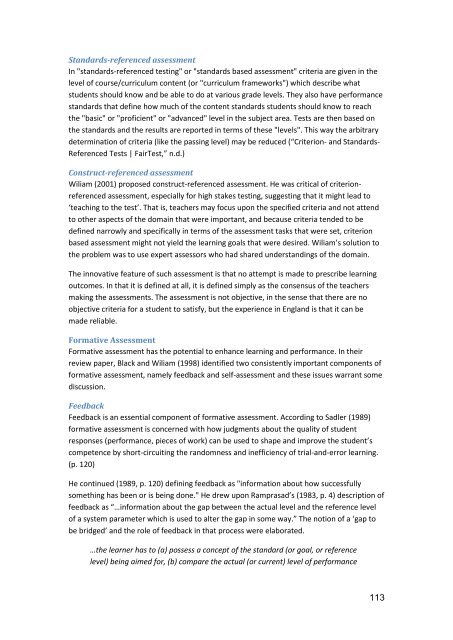Teaching and Assessing Soft Skills - MASS - Measuring and ...
Teaching and Assessing Soft Skills - MASS - Measuring and ...
Teaching and Assessing Soft Skills - MASS - Measuring and ...
You also want an ePaper? Increase the reach of your titles
YUMPU automatically turns print PDFs into web optimized ePapers that Google loves.
St<strong>and</strong>ards-referenced assessment<br />
In "st<strong>and</strong>ards-referenced testing" or "st<strong>and</strong>ards based assessment" criteria are given in the<br />
level of course/curriculum content (or "curriculum frameworks") which describe what<br />
students should know <strong>and</strong> be able to do at various grade levels. They also have performance<br />
st<strong>and</strong>ards that define how much of the content st<strong>and</strong>ards students should know to reach<br />
the "basic" or "proficient" or "advanced" level in the subject area. Tests are then based on<br />
the st<strong>and</strong>ards <strong>and</strong> the results are reported in terms of these "levels". This way the arbitrary<br />
determination of criteria (like the passing level) may be reduced (“Criterion- <strong>and</strong> St<strong>and</strong>ards-<br />
Referenced Tests | FairTest,” n.d.)<br />
Construct-referenced assessment<br />
Wiliam (2001) proposed construct-referenced assessment. He was critical of criterionreferenced<br />
assessment, especially for high stakes testing, suggesting that it might lead to<br />
‘teaching to the test’. That is, teachers may focus upon the specified criteria <strong>and</strong> not attend<br />
to other aspects of the domain that were important, <strong>and</strong> because criteria tended to be<br />
defined narrowly <strong>and</strong> specifically in terms of the assessment tasks that were set, criterion<br />
based assessment might not yield the learning goals that were desired. Wiliam’s solution to<br />
the problem was to use expert assessors who had shared underst<strong>and</strong>ings of the domain.<br />
The innovative feature of such assessment is that no attempt is made to prescribe learning<br />
outcomes. In that it is defined at all, it is defined simply as the consensus of the teachers<br />
making the assessments. The assessment is not objective, in the sense that there are no<br />
objective criteria for a student to satisfy, but the experience in Engl<strong>and</strong> is that it can be<br />
made reliable.<br />
Formative Assessment<br />
Formative assessment has the potential to enhance learning <strong>and</strong> performance. In their<br />
review paper, Black <strong>and</strong> Wiliam (1998) identified two consistently important components of<br />
formative assessment, namely feedback <strong>and</strong> self-assessment <strong>and</strong> these issues warrant some<br />
discussion.<br />
Feedback<br />
Feedback is an essential component of formative assessment. According to Sadler (1989)<br />
formative assessment is concerned with how judgments about the quality of student<br />
responses (performance, pieces of work) can be used to shape <strong>and</strong> improve the student’s<br />
competence by short-circuiting the r<strong>and</strong>omness <strong>and</strong> inefficiency of trial-<strong>and</strong>-error learning.<br />
(p. 120)<br />
He continued (1989, p. 120) defining feedback as "information about how successfully<br />
something has been or is being done." He drew upon Ramprasad’s (1983, p. 4) description of<br />
feedback as “…information about the gap between the actual level <strong>and</strong> the reference level<br />
of a system parameter which is used to alter the gap in some way.” The notion of a ‘gap to<br />
be bridged’ <strong>and</strong> the role of feedback in that process were elaborated.<br />
…the learner has to (a) possess a concept of the st<strong>and</strong>ard (or goal, or reference<br />
level) being aimed for, (b) compare the actual (or current) level of performance<br />
113





